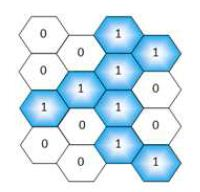



Departament Technologies of Computers & Communications
University of Extremadura
Escuela Politecnica. Campus Universitario s/n
E-10071 Caceres. SPAIN
Phone: +34-927-257263 — Fax: +34-927-257187
E-mail: {mavega, arl, dlga}@unex.es
Abstract
The Location Management of a mobile network is a major problem
nowadays. One of the most popular strategies used to solve this problem
is the Reporting Cells. To configure a mobile network is necessary to
indicate what cells of the network are going to operate as Reporting
Cells (RC). The choice of these cells is not trivial because they
affect directly to the cost of the mobile network. We have to solve the
Location Management, placing optimally the RC in a mobile network,
minimizing its cost.
Reporting Cells Planning
The Reporting Cells planning was proposed by Bar-Noy and
Kessler with the objective of minimizing the cost of tracking
mobile users.

Fig. 1. RC (1) and nRC (0)
According to the Reporting Cells scheme, there are two types of cells:
reporting cells (RC) and non-reporting cells (nRC), as shown in Fig. 1.
For all cells, RC and nRC, the vicinity factor is related by computing
the maximum number of neighbour cells that must be paged if an incoming
call occurs. Concretely, the vicinity factor of a single RC is given by
the number of nRC accessible from this RC, without crossing any other
RC and taking into account itself. On the other hand, the vicinity
factor of a nRC is given by the maximum value of the vicinity factors
of the RC’s accessible from this nRC. This means, if a nRC has more
than one neighbouring RC, it must perform this process for each of
them, using the highest value of vicinity factor.

Fig. 2. Reporting Cells Planning
As an example, in Fig. 2, the neighbouring cells of the cell 10 are the
cells 7, 9, 11, 12, 13 and the own cell 10. Then, the value of the
vicinity factor is 6, as it has six neighbouring cells (counting
itself). On the other hand, if we see the cell 4, we have the cells 2,
5, 6 and 8 as neighbouring reporting cells, with vicinity factors 4, 7,
6, and 7, respectively. To calculate the Location Management cost we
must select the highest value among them. In this case, the vicinity
factor of the cell 4 is 7.
Location Management includes two elementary operations when calculating the total cost: location updates (LU) and location inquiries/paging (P), causing updating and paging costs respectively. The updating cost is caused by the sum of the costs of updating the terminals location in the network when they change their location and must register another one. The paging cost is caused by the network during a location inquiry when the network tries to locate a user and, normally, the number of paging transactions is directly related to the number of incoming calls.
Location Management includes two elementary operations when calculating the total cost: location updates (LU) and location inquiries/paging (P), causing updating and paging costs respectively. The updating cost is caused by the sum of the costs of updating the terminals location in the network when they change their location and must register another one. The paging cost is caused by the network during a location inquiry when the network tries to locate a user and, normally, the number of paging transactions is directly related to the number of incoming calls.
The
cost of the location updates is given by NLU, the cost of the location
paging is given by NP, and finally, β is a constant that denotes the
cost ratio of location update to a paging transaction in the network.
It is proved that the updating cost is usually much higher than paging
cost. For this, the updating cost is usually considered about 10 times
greater than the paging cost, therefore β=10.
We get the following formula to calculate the location management cost of a particular reporting cells configuration:
We get the following formula to calculate the location management cost of a particular reporting cells configuration:
Where NLU (i) is the number of location updates for Reporting Cell
number i, S is the set of cells defined as reporting cells, the number
of arrived calls for cell i is NP (i), N is the total number of cells
in the network, V (i) is the vicinity factor for cell i and, finally, β
is a constant representing the cost ratio of a location update to a
paging transaction in the network, as described earlier. In conclusion,
given a mobile network, the goal is to select which of their cells must
act as RC to obtain the lowest possible cost.
TEST NETWORK "TN-13-30x30" (Size 900 cells)
TEST NETWORK "TN-14-45x45" (Size 2025 cells)
Last Update:
December 2009